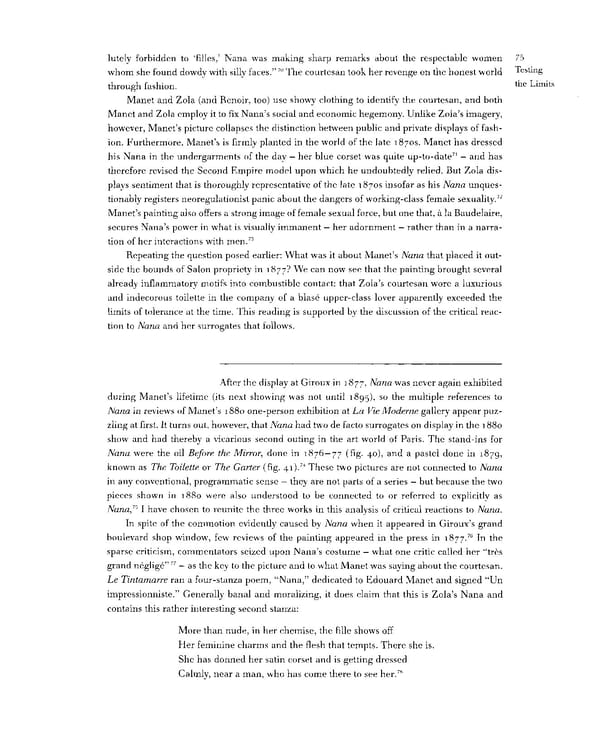lutely forbidden to 'filles,' Nana was making sharp remarks about the respectable women 75 70 Testing whom she found dowdy with silly faces." The courtesan took her revenge on the honest world through fashion. the Limits Manet and Zola (and Renoir, too) use showy clothing to identify the courtesan, and both Manet and Zola employ it to fix Nana's social and economic hegemony. Unlike Zola's imagery, however, Manet's picture collapses the distinction between public and private displays of fash- ion. Furthermore, Manet's is firmly planted in the world of the late 18708. Manet has dressed his Nana in the undergarments of the day - her blue corset was quite up-to-date71 - and has therefore revised the Second Empire model upon which he undoubtedly relied. But Zola dis- plays sentiment that is thoroughly representative of the late 18708 insofar as his Nana unques- 72 tionably registers neoregulationist panic about the dangers of working-class female sexuality. Manet's painting also offers a strong image of female sexual force, but one that, a la Baudelaire, secures Nana's power in what is visually immanent — her adornment — rather than in a narra- 73 tion of her interactions with men. Repeating the question posed earlier: What was it about Manet's Nana that placed it out- side the bounds of Salon propriety in 1877? We can now see that the painting brought several already inflammatory motifs into combustible contact: that Zola's courtesan wore a luxurious and indecorous toilette in the company of a blase upper-class lover apparently exceeded the limits of tolerance at the time. This reading is supported by the discussion of the critical reac- tion to Nana and her surrogates that follows. After the display at Giroux in 1877, Nana was never again exhibited during Manet's lifetime (its next showing was not until 1895), so the multiple references to Nana in reviews of Manet's 1880 one-person exhibition at La Vie Moderne gallery appear puz- zling at first. It turns out, however, that Nana had two de facto surrogates on display in the 1880 show and had thereby a vicarious second outing in the art world of Paris. The stand-ins for Nana were the oil Before the Mirror, done in 1876 — 77 (fig. 40), and a pastel done in 1879, 74 known as The Toilette or The Garter (fig. 4i). These two pictures are not connected to Nana in any conventional, programmatic sense — they are not parts of a series — but because the two pieces shown in 1880 were also understood to be connected to or referred to explicitly as 75 Nona, I have chosen to reunite the three works in this analysis of critical reactions to Nana. In spite of the commotion evidently caused by Nana when it appeared in Giroux's grand boulevard shop window, few reviews of the painting appeared in the press in i877/6 In the sparse criticism, commentators seized upon Nana's costume — what one critic called her "tres 77 grand neglige" — as the key to the picture and to what Manet was saying about the courtesan. Le Tintamarre ran a four-stanza poem, "Nana," dedicated to Edouard Manet and signed "Un impressionniste." Generally banal and moralizing, it does claim that this is Zola's Nana and contains this rather interesting second stanza: More than nude, in her chemise, the fille shows off Her feminine charms and the flesh that tempts. There she is. She has donned her satin corset and is getting dressed 78 Calmly, near a man, who has come there to see her.
 Prostitution & Impressionists Page 95 Page 97
Prostitution & Impressionists Page 95 Page 97